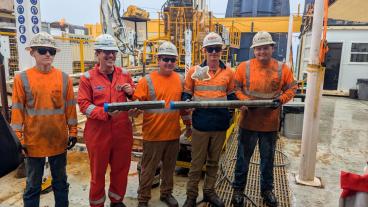Imagine a smaller version of the Blaster the Burro statue on campus with the same precision of detail. Professor Jered Dean and Dr. Douglas L. Van Bossuyt, along with three mechanical engineering graduate students from the Design Innovation and Computational Engineering Laboratory under the direction of Dr. Cameron Turner, created a one-twentieth-scale model of the mascot just last week. The new Blaster stands 2.5 inches tall.
As part of a tech fee proposal that was funded last spring, a 3D scanner was purchased for students to use for research and design. One 3D printer was loaned to group to use for experiments and test its capabilities. The group is submitting a tech fee proposal next week in hopes to fund additional 3D printers for students to use at a low cost (i.e. $3-5 a printed part). They are also working on collaborating with some of the 3D print houses in Denver.
Before 3D scanners, when an engineer would want to reproduce a part without a drawing, they would need to go through a time-consuming and often inaccurate set of measurements to document the part features and reproduce the part in a CAD model.
“A 3D scanner allows engineering designers to build upon or modify existing parts with relative ease, even if they do not have the drawings to the original part,” Turner said.
The activity of scanning Blaster was done to show off how powerful the combination of 3D Scanning and 3D Printing is. The process required 4.5 hours in total and the model produced consisted of 2.5 million points of data. The group used several algorithms to correct any errors they found. A program called a “slicer” converted the data into a series of machine codes, which drive a 3D printer. Once the printing was finished, the model was wrapped in scaffolding to protect the plastic from drooping during extrusion.
“I was actually blown away by the level of detail that it achieved, and the ease with which it was used, especially with no training or prior experience,” Graduate student Daniel Anderson said.
Graduate student John Steuben is currently working on the development of a low-cost attachment for smartphones, which would convert the phone's camera into a microscope 40 times the power of the standard instrument.
“I am hoping to develop this device with STEM education in mind, and produce it for a cost of less than $5 using 3D scanning and printing technology,” Steuben said.
Contact:
Kathleen Morton, Communications Coordinator / 303-273-3088 / KMorton@mines.edu
Karen Gilbert, Director of Public Relations / 303-273-3541 / KGilbert@mines.edu



